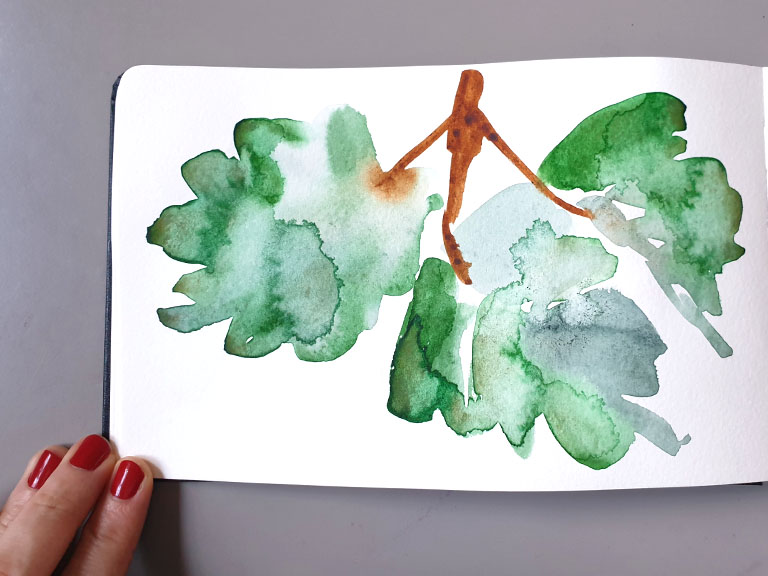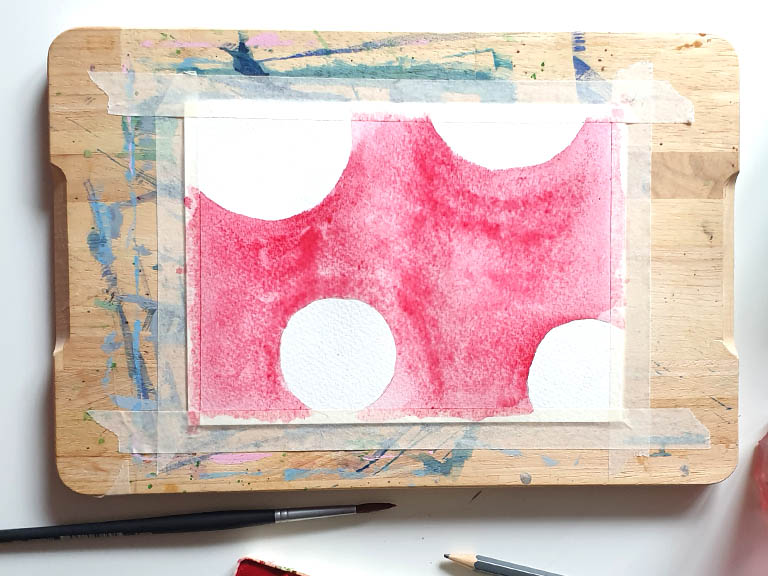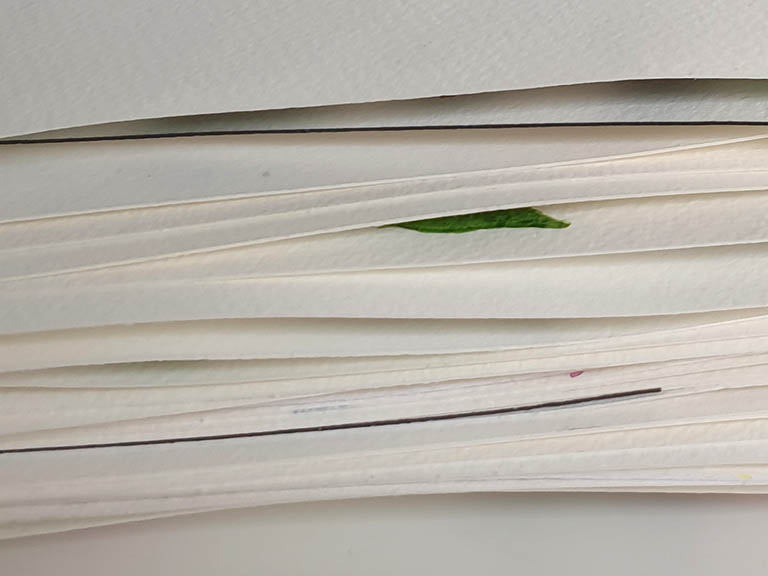If you’re reading this, you’re probably looking at a beautiful watercolour painting that you’ve just finished. And it’s warped, buckled, and it looks uneven. And no doubt you’re frustrated! I know I was always frustrated by warping when I started painting.
But fear not! We can save your painting and stop this happening so much in the future. Here’s my guide to watercolour paper warping so you can paint in peace!
Why does watercolour paper warp and buckle?
Watercolour paper warping occurs when the fibres in the paper absorb moisture unevenly, causing it to expand and contract in different places. The flat surface becomes warped and it dries stuck in this position.
Let’s imagine that when you paint on your paper, you’re adding water to the top of it. Those fibres will expand, yet the underneath of the paper will be dry. This causes the top of the paper to lift up as it grows, while the bottom pulls under, creating an arch.
And if you create puddles of really wet patches when you paint, the surface will be wetter and drier in different areas, creating uneven warping.
As the paper dries, the fibres will decrease in size again, but the paper may remain a little warped.
Keep reading: How much water to use in watercolour painting.

Why is warping in watercolour paper a problem?
The main problem is that buckling and warping in your paper can make it harder to paint. As it lifts up in areas, the surface becomes uneven and then the colours run and pool in the grooves. As this dries unevenly, it can create patchy effects and hard edges. Warped paper is also harder to display because it doesn’t sit flat against the wall or in a frame.
What makes the warping worse?
Too much water and puddles
When large amounts of water are applied to the paper during painting, it can provoke pools and puddles that create warping.
Not using watercolour paper
You’ll need to use paper that’s specifically designed for watercolour painting. It contains a special glue called ‘sizing’ that prevents too much water getting into the paper fibres and allows you time to mix and blend areas. If you’re painting on regular paper, make the switch to watercolour paper and see the difference.
Read my guide to choosing the best watercolour paper for you.
Low paper weight
Thin watercolour papers have fewer fibres, making them more prone to warping. Choosing a heavier weight paper can help – most good watercolour paper is 300 gsm (grams per square metre). Sketchbooks especially are prone to being thinner paper, sometimes 150-200 gsm.
Uneven drying
If you’re speeding up drying with a hairdryer (and I see you, impatient friends!), you can accidentally create warping in your watercolour paper. Keep the hairdryer nozzle moving around the paper to dry it evenly, and don’t let any patches overheat.

How to stop watercolour paper from warping
To prevent watercolour paper from warping and buckling, you can try these tips. Remember that if you’re using a lot of water there will always be some warping, but these tips should help minimise it.
- Pick up your puddles. Try and spot puddles as you paint and pick up the excess with a dry brush or paper towel.
- Apply washes gradually. Instead of adding large volumes of water in one go, apply washes gradually, allowing each layer to dry before adding the next.
- Take a break and let it dry a little. If your paper is starting to buckle, take a short break and let the excess water dry off, before adding anything else.
- Tape down the edges. I like to hold the paper in place with masking tape, to stop it lifting up around the edges. Some people tape it to their desks but I prefer to fix the paper to an old wooden chopping board so I can move the board around if needed. Tape on all four sides to hold it still.
- Let it dry taped down. Leave your painting to dry with the masking tape still on and you might find it flattens down again as it dries. Peel the tape up carefully, pulling backwards on a diagonal to avoid ripping the paper edges.
- Grab a stronger paper. Choose a heavyweight watercolour paper, preferably 300 gsm. You may find that cotton papers are stronger than student papers, which are often made of wood pulp.
- Use a watercolour paper block. I mostly paint with watercolour blocks for larger pieces, because they’re so convenient. The paper comes in a pad but it’s glued down on two or four sides, meaning it can’t warp as much. It’s a little more expensive but it saves a lot of heartache and frustration!
- Stretch your paper properly. If you’re struggling with a lot of warping even on premium papers, you might want to try stretching. Caveat upfront that this technique is fiddly, won’t work on cheap papers and is probably not necessary for beginners. I almost never stretch paper, relying on simple masking tape and paper blocks.
Bonus: How to stretch your watercolour paper
Prep your paper by thoroughly wetting both sides in a layer of clean water. Lay out on a flat surface like a wooden board and pull and stretch the paper tight. Tape down the edges with strong painters tape, or staple it down. Allow to dry completely before painting on it.
Some artists swear by stretching their papers, but I find it difficult and fiddly to lift them off the board. You’d probably have to just cut the edges off next to the tape because it won’t peel, and this is too faffy for my impatient brain. But if stretching works for you, go for it and enjoy warp-free painting!

How to flatten watercolour paper that’s dried buckled and warped
If your watercolour paper has already buckled, there are effective ways to flatten it:
Try to press it flat
For mild buckling, place heavy, flat objects like books or boards on top of the paper and leave them for a day or two. This helps to slowly flatten the paper over time. Ensure even distribution of weight to avoid further damage. You can also press it behind glass in a picture frame.
Wet the back
If your paper won’t flatten down after that, try moistening the back of the paper using a clean sponge or spray bottle. Place the dampened paper between two clean, absorbent blotting materials, such as paper towels or blotters. Apply pressure evenly to encourage drying flat, perhaps by placing large cookbooks over them. Leave for a day or two.
Iron your paper
Ironing should be a last resort for stubbornly buckled paper. Too much heat may burn or damage your paper. Place a clean cotton or linen cloth over the buckled area and gently iron over it on the reverse side with a low-heat setting. Check the paper frequently to avoid overheating, and never apply direct heat to the paper itself.
Watercolour paper warping and buckling can be frustrating for artists, but with the right techniques and precautions, you can stop it ruining your work.
Want more watercolour advice?
Download my free watercolour supply guide
Feeling overwhelmed and confused by watercolour paints, papers and brushes? Download my free guide filled with insider info, including a list of good supplies for every budget, and my complete supply list!
